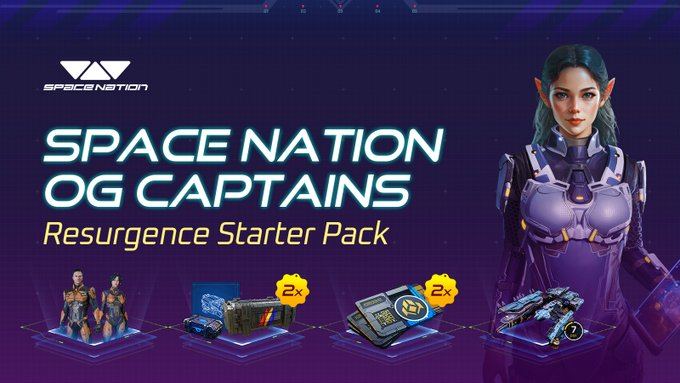Space Nation: A Space Opera Redefining the Boundaries of Web3 Gaming
Space Nation is a AAA-level blockchain game co-created by Jerome Wu, former product manager of World of Warcraft China, and Hollywood director Roland Emmerich (Independence Day, 2012). The project aims to resolve two major conflicts between traditional games and blockchain economics: lack of true asset ownership for players, and the prevalence of profit-driven but experience-poor blockchain games. By merging deep storytelling with decentralized economics, Space Nation builds an open universe named Telikos Cluster, supporting PvE/PvP interstellar battles, resource mining, and an NFT crew system. It raised $50 million in 2019 (led by Foresight Ventures), and on July 8, 2025, its token OIK was listed on Binance Alpha, marking its entry into the mainstream market.

This Token Insights article explores how Space Nation combines Web2 gameplay with Web3 asset ownership, decoding its dual-token model and Hollywood-level storytelling.
Technical Architecture: Immersive Universe and Asset Ownership
High-Performance Base Layer Built on Immutable zkEVM
Space Nation uses the Immutable zkEVM tech stack for its backend, supporting high-concurrency transactions and gas fees below $0.001. In the Telikos Cluster open universe, players can engage in three core activities: interstellar exploration and battles, resource mining and crafting, and NFT crew management. The crew system is the most innovative—each NFT character has a unique skill tree (e.g., engineers improve shield efficiency), directly influencing fleet combat strategies.
Dynamic NFT Asset System
In-game assets exist as dynamic NFTs:
-
Spaceship NFTs: Include combat ships, mining vessels, etc., with attributes that evolve over time;
-
Crew NFTs: Rarity affects skill strength, and they can be traded or rented;
-
Genesis NFTs: The Alpha Gate series (limited to 515 pieces) grants early testing access and has a floor price of 1.2 ETH.
These assets are traded on decentralized markets, ensuring real ownership and cross-ecosystem portability.
Token Economy: Dual-Track Model for Sustainable Ecosystem
OIK Token: Core for Governance and Ecosystem
OIK has a total supply of 1 billion, unlocked linearly over 10 years. Key allocations include:
-
50% for community incentives (rewarded via a “Proof of Contribution” system);
-
20% for team and investors (locked for 12 months, then linear release);
-
5% for DAO treasury (protocol revenue used for buybacks).
Main utilities include governance voting (e.g., adjusting NFT royalty rates), staking to earn veOIK for voting weight, and redeeming real-world brand perks (e.g., club memberships).
CHR Stablecoin: In-Game Economic Anchor
CHR, pegged to USDC, handles in-game circulation:
-
Repairing ship damage;
-
Crafting equipment and consumables;
-
Crew skill upgrades.
Its supply dynamically adjusts based on server activity to prevent inflation.
Economic Health Metrics
90% of game revenue is reinvested into ecosystem development. The key metric is CHR burn rate—must reach 70% of output to maintain balance. Full analysis of the dual-token model is available in the JuCoin Economic Research Report.
Development Progress: Exchange Listings and Ecosystem Expansion
2025 Key Milestones
-
Binance Alpha Listing (July 8, 2025): Users with ≥140 points can redeem 750 OIK (costing 15 points); a 5 million OIK trading contest also launched.
-
Closed Beta Data: Over 100,000 players participated; daily active addresses reached 25,000; Genesis NFT trades exceeded 8,000.
-
Hollywood IP Expansion: Roland Emmerich’s team produced animated series for the main storyline, with a spin-off series slated for Q4 2025.
Strategic Partnership Network
-
Epic Games Store: SDK integration tests lower entry barriers for players;
-
Magic Eden: Supports secondary market trading of spaceship NFTs;
-
Yield Guild: Offers new player equipment rentals with revenue-sharing terms.
Challenges and Prospects: Breaking Through AAA Blockchain Game Barriers
Risk Alerts
The biggest challenge is balancing the dual-token system—if CHR demand falls, OIK value may be affected. The game also faces user fragmentation from platforms like Immutable X (2 million users) and the high cost of continuous AAA development.
Growth Catalysts
Hollywood resources are a unique edge—Roland Emmerich’s storytelling could attract non-crypto users. If 30% of the airdrop participants stake their rewards in the first season, it could help stabilize prices. Closed beta data shows players averaged 4.2 hours of gameplay daily, proving strong game design.
Industry Benchmark
Space Nation is driving the shift from “Play-to-Earn” to “Play-to-Own”:
Players truly own their ships, crew, and assets, and gain long-term value through narrative immersion. The Q4 2025 goal is 500,000 MAUs, with DAO voting participation above 20%. If achieved, Space Nation will become the first AAA blockchain game to validate the “gameplay + asset sovereignty” model.
The essence of the blockchain gaming revolution is enhanced user experience—Space Nation’s Hollywood-level storytelling and dual-token model set a new gold standard for Web3 gaming.





